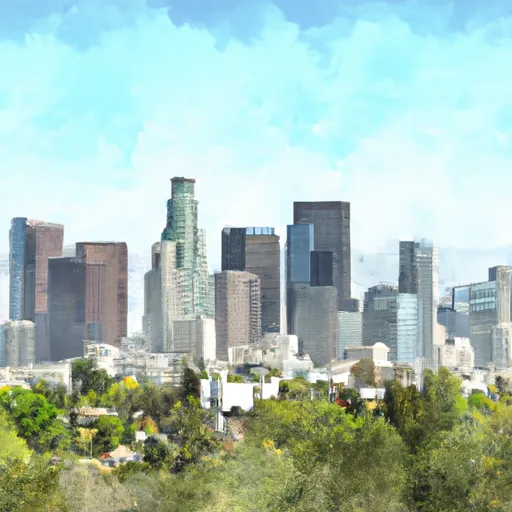-
 Snoflo Premium
Snoflo Premium
Get unlimited access to all our content
With no Ad interruptions! - Start Your Free Trial Login with existing account
Los-Angeles
Eden Index
Climate
9.2
•
Recreation
4.2
•
Community
1.5
•
Safeguard
5.5/10

Los Angeles, California, is a vibrant city located on the west coast of the United States. Known for its sunny and mild climate, the city experiences a Mediterranean climate with hot summers and warm winters. Summers are typically dry, with temperatures ranging from 70°F to 90°F, while winters are cooler, with temperatures ranging from 50°F to 70°F. The city enjoys over 300 days of sunshine annually.
Hydrologically, Los Angeles is situated in the Los Angeles River watershed and is bordered by the Pacific Ocean. The city's primary source of water is the Los Angeles Aqueduct, which brings water from the Eastern Sierra Nevada Mountains. The city's water management focuses on conservation and efficient use of water resources.
Los Angeles offers a diverse range of outdoor recreation opportunities. The city is home to stunning beaches, including Santa Monica and Venice Beach, where visitors can enjoy swimming, surfing, and beach volleyball. Additionally, the nearby Santa Monica Mountains provide ample hiking, biking, and horseback riding trails. Griffith Park, one of the largest urban parks in North America, offers panoramic views of the city, hiking trails, and the iconic Griffith Observatory. Whether it's coastal activities, mountain adventures, or exploring urban parks, Los Angeles offers something for everyone seeking outdoor recreation.
What is the Eden Index?
The Snoflo Eden Index serves as a comprehensive rating system for regions, evaluating their desirability through a holistic assessment of climate health, outdoor recreation opportunities, and natural disaster risk, acknowledging the profound impact of these factors on livability and well-being.
Climate Health Indicator (CHI): 9.2
Los-Angeles receives approximately
381mm of rain per year,
with humidity levels near 58%
and air temperatures averaging around
19°C.
Los-Angeles has a plant hardyness factor of
10, meaning
plants and agriculture in this region tend to thrive here all year round.
By considering the ideal temperature range, reliable water supplies, clean air, and stable seasonal rain or snowpacks, the Climate Health Indicator (CHI) underscores the significance of a healthy climate as the foundation for quality living.
A healthy climate is paramount for ensuring a high quality of life and livability in a region, fostering both physical well-being and environmental harmony. This can be characterized by ideal temperatures, reliable access to water supplies, clean air, and consistent seasonal rain or snowpacks.
Weather Forecast
Streamflow Conditions
Ventura-San Gabriel Coastal
Area Rivers
Ventura-San Gabriel Coastal
Snowpack Depths
Ventura-San Gabriel Coastal
Reservoir Storage Capacity
Ventura-San Gabriel Coastal
Groundwater Levels
Recreational Opportunity Index (ROI): 4.2
The Recreational Opportunity Index (ROI) recognizes the value of outdoor recreational options, such as parks, hiking trails, camping sites, and fishing spots, while acknowledging that climate plays a pivotal role in ensuring the comfort and consistency of these experiences.
Access to outdoor recreational opportunities, encompassing activities such as parks, hiking, camping, and fishing, is crucial for overall well-being, and the climate plays a pivotal role in enabling and enhancing these experiences, ensuring that individuals can engage in nature-based activities comfortably and consistently.
Camping Areas
| Campground | Campsites | Reservations | Toilets | Showers | Elevation |
|---|---|---|---|---|---|
| Devore | 6 | 2,914 ft | |||
| Los Alamitos Army Military | None | 25 ft | |||
| Dockweiler Beach RV | 117 | 45 ft | |||
| Bolsa Chica State Beach | 57 | 12 ft | |||
| Gould Mesa | 7 | 1,418 ft | |||
| Messenger Flats | 10 | 5,793 ft | |||
| Oakwilde | 7 | 1,831 ft | |||
| Millard | 5 | 1,980 ft | |||
| Seabreeze at Seal Beach Military | None | 15 ft | |||
| Monte Cristo | 19 | 3,589 ft |
Catastrophe Safeguard Index (CSI):
The Catastrophe Safeguard Index (CSI) recognizes that natural disaster risk, encompassing floods, fires, hurricanes, and tornadoes, can drastically affect safety and the overall appeal of an area.
The level of natural disaster risk in a region significantly affects safety and the overall livability, with climate change amplifying these risks by potentially increasing the frequency and intensity of events like floods, fires, hurricanes, and tornadoes, thereby posing substantial challenges to community resilience and well-being.
Community Resilience Indicator (CRI): 1.5
The Community Resilience Indicator (CRI) recognizes that education, healthcare, and socioeconomics are crucial to the well-being of a region. The CRI acknowledges the profound impact of these elements on residents' overall quality of life. By evaluating educational resources, healthcare accessibility, and economic inclusivity, the index captures the essential aspects that contribute to a thriving community, fostering resident satisfaction, equity, and social cohesion.

